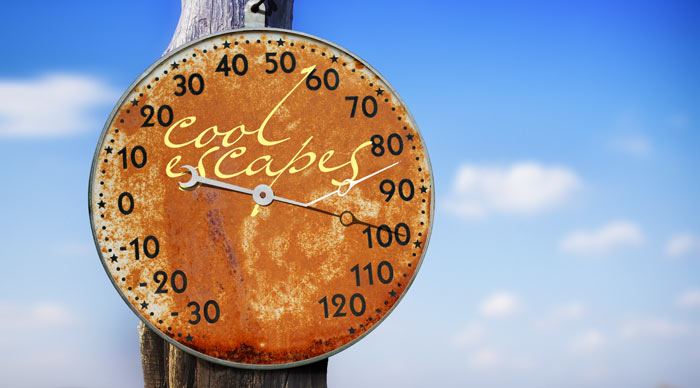
Hot weather arrived early this summer, and each day feels like it brings record-breaking temperatures. If everything around you is parched, maybe it’s time for a trip to a cooler climate. We’ve come up with five distinct destinations that are sure to give you some relief from the barrage of humidity and scorching temps, whether now or this fall.
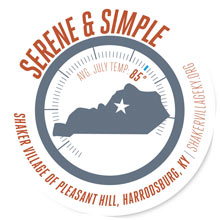
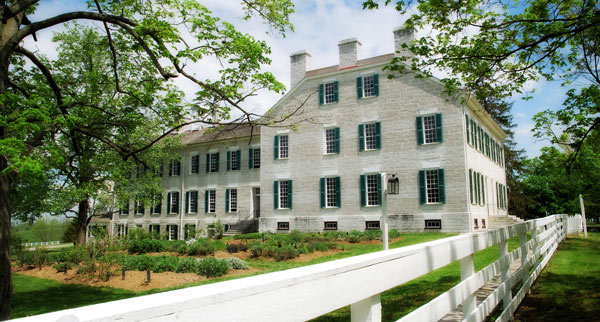
Shaker Village / Photo by Shackleford Photography
Step back in time at this truly authentic 2,900-acre Shaker community that is part living history museum, part rustic resort. Thirteen of Shaker Village’s 34 original buildings are set aside for lodging, and many people come here to reconnect with nature and a simpler way of life, including actress Ashley Judd who also happens to serve on the board of trustees.
Shakers, the largest and best-known communal society in 19th century America, established Pleasant Hill in 1805 on a limestone bluff about 30 miles from Lexington, Kentucky. The sect chose a peaceful way of life with a quest for simplicity and perfection. Although Shakers no longer exist in Kentucky, their dedication to perfection is still evident in the architectural details and craftsmanship of the original buildings. Today, architects marvel at the perfect symmetry of the spiral staircases in the building once used as the trustees office that now houses the registration area and restaurant.
Shaker Village of Pleasant Hill is a non-profit National Historic Landmark that seeks to preserve the legacy of the remarkable society that lived in the area until 1910. The property began hosting overnight visitors in the late 1960s after the abandoned buildings were restored. It has since become a destination for those who want to leave behind their worries and stress for a few days.
“This place is all about having an authentic experience where you can reconnect with nature and the past,” says publicist Aimee Darnell, who has worked at Shaker Villages for five years. “We try to create a real farm experience, especially for children, who may have never seen a working farm.”
Although the experience is definitely authentic, modern conveniences do exist. Several of the inn’s rooms have Internet access, and all of the inn’s beds feature TempurPedic mattresses on Shaker-style furniture.
With more than 40 miles of hiking, biking and equine trails, and a 1,000-acre nature preserve, Shaker Village is a refuge for outdoor enthusiasts. A maple tree-lined pathway is the perfect place to stroll from one building to another and past the lush gardens. A short walk leads you past Shaker Village’s favorite pet McDuffie, a Scotts Highland steer.
“Shakers raised this type of animal, and he’s become iconic for us,” says Aimee. “He is so popular that we’re even thinking about creating a Twitter page for him.”
A weekend in Shaker Village offers a lot more than peaceful walks in the woods, however. Summer months are filled with craft workshops, musical programs, cooking classes, antique shows and cruises along the Kentucky River aboard the Dixie Belle riverboat. Fall officially begins with a HarvestFest in late September and is followed by “Fall-on-the-Farm” weekends in October, where guests learn to make not only butter but cider from apples picked from the property’s orchard. In December, private quail hunts can be arranged on the wildlife preserve that has become a model for nature conservationists and private landowners.
With all of the healthy activities to choose from, guests work up an appetite, and the on-site dining room serves traditional favorites and Kentucky specialties. Food and herbs grown in the gardens are used in the family-style restaurant, where Vice President David Larson has recreated many original Shaker recipes, including a tangy lemon pie that makes mouths pucker and water at the same time.
“The Shakers’ philosophy was waste-not, want-not,” says Larson, formerly a James Beard award-winning chef. “They even used the rinds from the lemons that were shipped in by riverboat. The rinds give the pie a tartness that is unusual and delicious.”
After dinner, sit by the outdoor fire pits where you can share stories with fellow guests or just reflect in peace and quiet about how life’s simple pleasures are often the best.

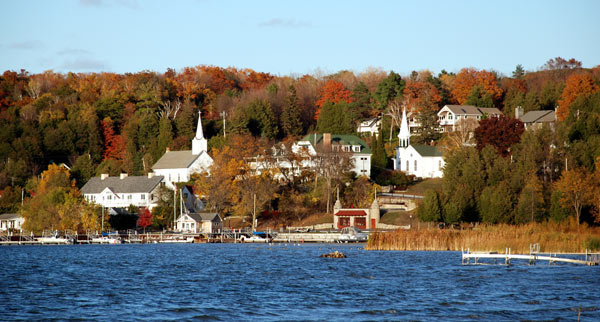
Ephraim, Wisconsim / Photo Courtesy of Door County Visitors Bureau
Midwesterners have known for years that Door County is a treasure, especially during the summer and fall. Now that Money Magazine has named the 70-mile long peninsula one of its “Top 10 Vacation Destinations in America,” the secret is out, and more than 2 million visitors a year agree. Jutting into Lake Michigan, this northeast Wisconsin county is dotted with so many charming little towns that it’s hard to decide where to stay. And it’s even harder to decide what to do first, because the area has so many parks, lighthouses, art galleries, museums, outdoor recreational activities and shopping opportunities.
“Door County is a culturally diverse area that is well worth a trip from Florida,” says Carol Borycki, who lives in The Villages seven months a year but returns to her home in Egg Harbor, Wisconsin, every summer. “We have many events and festivals, art showsand musical and theater offerings every summer, but the parks are really special all year. I always recommend visiting Peninsula State Park for its beautiful trails and stunning views of the bay.”
Visitors from coastal states are often surprised by Door County’s rich maritime history. Sturgeon Bay, the county seat, is home to the Door County Maritime Museum, which opened in 1996. An initial stop at this delightful, well-organized museum is worth the time to understand the area’s history and how the town became an important shipbuilding center for the entire U.S. The museum also has a fascinating, interactive display of shipwrecks in the Great Lakes, many of which attract scuba divers during the summer months.
If you decide to eat or stay in Sturgeon Bay before heading up the coastline, be sure to stop at The Inn at Cedar Crossing, consistently ranked as one of America’s top bed and breakfast inns and restaurants by Midwest Living, TripAdvisor and others.
The Door County Coastal Byway runs through quaint and charming harbor villages, each with its own unique attractions. The scenic byway begins just north of Sturgeon Bay where Highways 42 and 57 fork. Take Highway 57 north along the Lake Michigan side, and stop at the Cana Island Lighthouse in Baileys Harbor. Built in 1869, the lighthouse is one of the Great Lakes’ most photographed icons and offers exhilarating views of the rocky Lake Michigan shoreline below. Also located in Baileys Harbor is Ridges Sanctuary, the state’s oldest nonprofit nature preserve and an Audubon-sanctioned bird area with five miles of rustic trails to explore.
From Baileys Harbor, continue across Door County to Sister Bay, where everyone does a double-take at the goats grazing on the sod roof of Al Johnson’s Swedish Restaurant. For more than 60 years, the restaurant has served a variety of Swedish fare for breakfast and lunch. It’s the grazing goats, however, that often cause traffic jams in the summer.
Art lovers and artists will want to spend time at the Peninsula Art School and Guenzel Gallery in Fish Creek, located on the Green Bay side of the peninsula. This center for visual arts offers year-round programming and one- to five-day workshops in ceramics, jewelry and metal arts, photography, watercolor, printmaking and more. The school annually sponsors the Midwest’s largest Plein Air Festival, where artists from all over the nation paint outdoors. This year’s event is scheduled for July 23-28.
While in Fish Creek, be sure to visit the White Gull Inn, the only place where the traditional Door County “fish boil” is offered year round. White fish from Lake Michigan are boiled with red potatoes and onions in a huge outdoor kettle over an open wood fire. When the fiery “boil over” blazes up, delighted onlookers know the flames mean a feast will soon begin. Pie made with Door County cherries is the perfect ending to an evening as the Lake Michigan breezes make you forget the sticky temps back home.

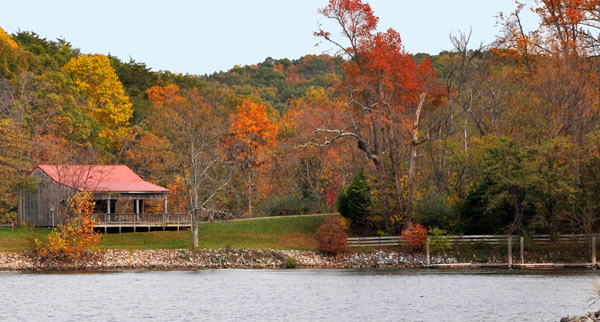
Photo by Mary Ann DeSantis
If you love water sports and the mountains, Smith Mountain Lake may be the coolest place to combine those loves this summer. The 40-mile-long lake is often called “the jewel of the Blue Ridge” because of its idyllic scenery, perfect climate and prime location between Roanoke and Lynchburg. Nestled in the Blue Ridge Mountains, the lake offers camp sites as well as luxury vacation rentals.
With more than 500 miles of shoreline, water sports dominate. Fishing, recreational boating, wakeboarding, swimming and water skiing are the allure for most visitors. House boat and pontoon rentals are also available for a minimum of three days.
Even if you don’t have a boat, Smith Mountain Lake still has a lot to offer, including an overview tour aboard the “Virginia Dare,” a 19th century replica side wheeler. The cruise is a great way to learn about the lake’s islands and coves, wildlife and the nearby Smith Mountain Lake State Park.
Two resorts, Bernard’s Landing Resort & Conference Center and Mariner’s Landing Resort, are on opposite sides of the lake. Bernard’s offers a private beach, golf, tennis and even parasailing adventures. Mariner’s Landing Resort also offers golf and conference facilities.
Smith Mountain Lake is near the Blue Ridge Parkway, ranked as one of America’s most scenic drives. A nearby attraction is the Peaks of Otter, a 5,000-acre area with hiking trails leading to three distinctive peaks preserved by the National Park Service.
While summer is a great time to enjoy water sports, fall offers picture-perfect scenery with changing colors and cool, crisp air. Visitors can take time to enjoy the area’s boutiques, restaurants and shops filled with antiques and art.
On the last weekend of September, the 23rd Annual Smith Mountain Lake Wine Festival will attract hundreds of visitors not only for wine tastings from 27 Virginia wineries but also for a continuous outdoor concert and a juried craft festival. For information, visit smlwinefestival.com.
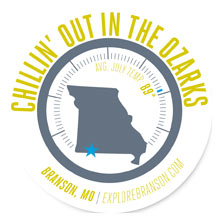
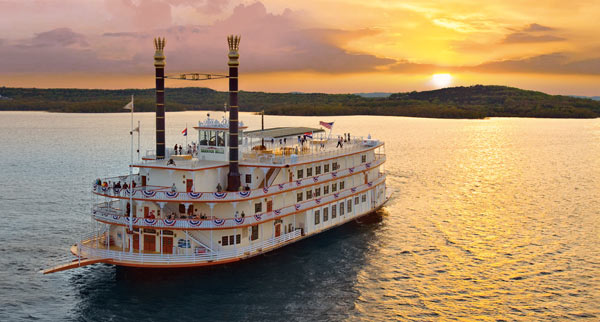
Branson Belle Showboat / Photo Courtesy of Silver Dollar City
Sometimes the only place to escape the heat is indoors. With 100 live performances a day in more than 50 state-of-the-art theaters, Branson offers visitors many options for finding a cool show. Performances often begin as early as 10am, and some folks take in more than one show a day, especially during the summer.
Baby Boomers may think Branson only offers their parents’ kind of entertainment, but all that has changed. Even at the long-standing Andy Williams’ Moon River Theatre, the Jersey Boy sound of the singing group “Oh What a Night” is winning over younger audiences. “The Legends of Kung Fu,” at the White House Theatre has mesmerized audiences around the world with its Cirque du Soleil-like combinations of traditional martial arts, aerial ballet, dance and music. With a cast of 65 performers, magnificent scenery and lots of special effects, Legends of Kung Fu was named Branson’s Production Show of the Year in 2011.
Music styles in the live music capital of America—as Branson bills itself—encompass pop, country, rock n’ roll, Broadway, big band, classical and much more, but the common denominator is family-friendly entertainment. Theaters emphasize that shows are appropriate for all ages.
2012 has been a hot year for Branson as it celebrates its 100th anniversary as an incorporated city, although the natural beauty of the Ozark Mountains attracted “tourists” to the area in the 1800s. A 1907 novel set in the area, The Shepherd of the Hills by Harold Bell Wright fascinated readers worldwide, and the stampede to the logging town began.
To mark the anniversary, the city is celebrating with special events and the opening of the new Centennial Heritage Museum. In addition, Branson’s tastefully done and historically accurate Titanic Museum marks the 100th anniversary of the ship’s fateful voyage with special exhibits.
Although the Show-Me State temperatures can surpass the Sunshine State’s in the summer, there are plenty of ways to stay cool while outdoors. Don’t miss the splashdown in a World War II amphibious vehicle, known as a DUKW. The vehicles are seen all over Branson as they make their way to Table Rock Lake just west of the city. Keep your cameras covered because you will get a little wet as the open air vehicle makes a bumpy descent into the lake.
Silver Dollar City, the largest family-owned theme park in the U.S., makes 7,000 gallons of ice cream a year—always good on a warm, summer day. Youngsters won’t want to miss the exciting PowderKeg roller coaster and other rides, while moms can enjoy a cooking class at Silver City’s Culinary School in an 1880s-style farmhouse. Still in search of cooler temps? Explore Marvel Cave, which is a wet limestone cave that the theme park literally evolved around. Be prepared to walk 600 steps down to the Cathedral Room, the largest cave entrance in the U.S.
Silver Dollar City also owns the Showboat Branson Belle, known as the Queen of the Ozarks. The 700-seat riverboat cruises for two hours around Table Rock Lake, while guests enjoy entertainment and a chef-prepared meal. The lake views are spectacular, especially at sunset, but you’ll want to come inside for the variety show, which includes a spellbinding performance by Janice Martin, the world’s only aerial violinist.
As fall approaches, the colorful beauty of the Ozarks rivals the Great Smoky Mountains. The Dogwood Canyon Nature Park offers hiking and biking as well as horseback or ATV riding along pristine trails in the heart of the Ozarks. The 2,200-acre preserve features natural waterfalls and fishing ponds where you can even take fly fishing lessons.

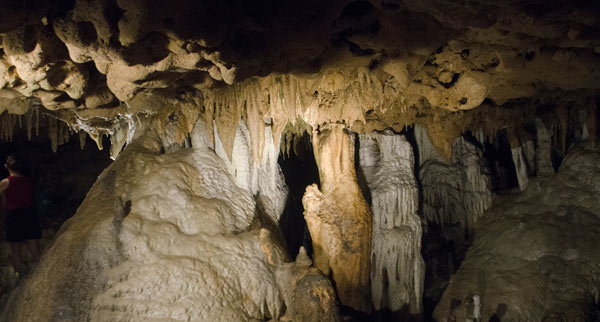
Florida Caverns / Photo by Tony DeSantis
Imagine a place in Florida that stays 65 degrees year-round. If a long weekend in the Sunshine State is all your budget can handle, a drive to the Panhandle town of Marianna will take you to the hottest cool place around. About an hour west of Tallahassee, Florida Caverns State Park is home to the state’s only cave open for public tours. Temperatures outside may be boiling, but the maze of caves stays naturally cool.
The 45-minute guided tours through the underground system of caverns are hot sellers, especially in the summer. Park rangers offer lively and humorous tours while explaining the state’s unique geological history that began approximately 38 million years ago. The entire southeastern coastal plain was once under water. When the waters receded, shells, coral and sediments on the sea floor hardened into limestone, and acidic water created crevices just below the limestone surfaces. Dripping water formed stalactites hanging from the ceiling, while mineral deposits created stalagmites reaching up from the floor. The colorful cave formations are beautiful photographic subjects. Tripods are not allowed, but flash photography is OK.
Each cavern “room” is named for a predominant speleothem (cave formation). A formation resembling a wedding cake dominates The Wedding Room, where brides and grooms can actually exchange vows as long as they bring their own officiator and pay the $150 rental fee. In the South American room, a shimmering rim stone pool resembles the southern continent. And, of course, there’s no mistaking why Short Man’s Revenge received its name when visitors enter the 4-foot-high room.
The tour moves along quickly enough that claustrophobia is seldom an issue, but if it is, the tour guide will escort you to one of the nearby exits. Tours are offered Thursday through Monday and cost $8 for adults and $5 for children over the park entrance fee. No tours are given on Tuesdays or Wednesdays.
While the tour’s geology lesson is interesting, the cave’s history is just as fascinating. Spanish explorers described the caves as early as 1693. Seminole Indians hid there during the Seminole Wars as did residents of nearby Marianna during the Civil War. In 1936, the Depression-era Civilian Conservation Corps (CCC) excavated tons of rock to open the cave’s interior spaces and install lighting. Many of the workers were teenage boys who were paid $1 a day to help create a natural attraction.
You can’t spend all of your time hiding in the cave to escape the heat, but you can cool off in the Blue Hole Spring swimming and recreation area of the 1,300-acre state park. Canoeing, kayaking, tubing and fishing are also available on the spring-fed Chipola River that borders the park. Hiking, biking and horseback riding are additional options. Even golf is available at the adjacent Florida Caverns Golf Course, a nine-hole course built in Marianna’s beautiful rolling terrain during the 1930s.
Florida Caverns State Park is located off Interstate 10 at Exit 142. Camping and RV sites are available inside the park, but sites fill quickly during the summer and reservations are required. A variety of lodging is also available nearby, including the historic Hinson House Bed and Breakfast in downtown Marianna. Florida Caverns is also a perfect day trip from the Panhandle beaches.






